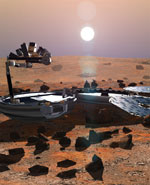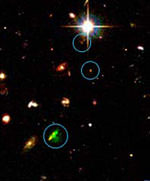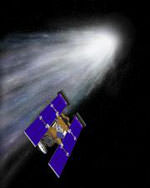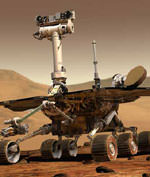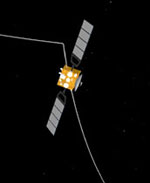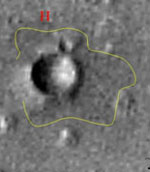
Image credit: NASA
A team of scientists have discovered bacteria inside a hole that was drilled 1,350 metres into the volcanic rock near Hilo, Hawaii. The hole began in igneous rock on the Mauna Loa volcano, and then passed through lava from Mauna Kea. At 1,000 metres they encountered fractured basalt glass which formed when the lava flowed into the ocean. Upon close examination, they found that this lava had been changed by microorganisms. Using electron microscopy, they found tiny microbe spheres, and they were able to extract DNA. Scientists are finding life in more remote regions of the planet, and this gives hope that it might be on the other planets in our solar system as well.
A team of scientists has discovered bacteria in a hole drilled more than 4,000 feet deep in volcanic rock on the island of Hawaii near Hilo, in an environment they say could be analogous to conditions on Mars and other planets.
Bacteria are being discovered in some of Earth’s most inhospitable places, from miles below the ocean’s surface to deep within Arctic glaciers. The latest discovery is one of the deepest drill holes in which scientists have discovered living organisms encased within volcanic rock, said Martin R. Fisk, a professor in the College of Oceanic and Atmospheric Sciences at Oregon State University.
Results of the study were published in the December issue of Geochemistry, Geophysics and Geosystems, a journal published by the American Geophysical Union and the Geochemical Society.
“We identified the bacteria in a core sample taken at 1,350 meters,” said Fisk, who is lead author on the article. “We think there could be bacteria living at the bottom of the hole, some 3,000 meters below the surface. If microorganisms can live in these kinds of conditions on Earth, it is conceivable they could exist below the surface on Mars as well.”
The study was funded by NASA, the Jet Propulsion Laboratory, California Institute of Technology and Oregon State University, and included researchers from OSU, JPL, the Kinohi Institute in Pasadena, Calif., and the University of Southern California in Los Angeles.
The scientists found the bacteria in core samples retrieved during a study done through the Hawaii Scientific Drilling Program, a major scientific undertaking run by the Cal Tech, the University of California-Berkeley and the University of Hawaii, and funded by the National Science Foundation.
The 3,000-meter hole began in igneous rock from the Mauna Loa volcano, and eventually encountered lavas from Mauna Kea at 257 meters below the surface.
At one thousand meters, the scientists discovered most of the deposits were fractured basalt glass – or hyaloclastites – which are formed when lava flowed down the volcano and spilled into the ocean.
“When we looked at some of these hyaloclastite units, we could see they had been altered and the changes were consistent with rock that has been ‘eaten’ by microorganisms,” Fisk said.
Proving it was more difficult. Using ultraviolet fluorescence and resonance Raman spectroscopy, the scientists found the building blocks for proteins and DNA present within the basalt. They conducted chemical mapping exercises that showed phosphorus and carbon were enriched at the boundary zones between clay and basaltic glass – another sign of bacterial activity.
They then used electron microscopy that revealed tiny (two- to three-micrometer) spheres that looked like microbes in those same parts of the rock that contained the DNA and protein building blocks. There also was a significant difference in the levels of carbon, phosphorous, chloride and magnesium compared to unoccupied neighboring regions of basalt.
Finally, they removed DNA from a crushed sample of the rock and found that it had come from novel types of microorganisms. These unusual organisms are similar to ones collected from below the sea floor, from deep-sea hydrothermal vents, and from the deepest part of the ocean – the Mariana Trench.
“When you put all of those things together,” Fisk said, “it is a very strong indication of the presence of microorganisms. The evidence also points to microbes that were living deep in the Earth, and not just dead microbes that have found their way into the rocks.”
The study is important, researchers say, because it provides scientists with another theory about where life may be found on other planets. Microorganisms in subsurface environments on our own planet comprise a significant fraction of the Earth’s biomass, with estimates ranging from 5 percent to 50 percent, the researchers point out.
Bacteria also grow in some rather inhospitable places.
Five years ago, in a study published in Science, Fisk and OSU microbiologist Steve Giovannoni described evidence they uncovered of rock-eating microbes living nearly a mile beneath the ocean floor. The microbial fossils they found in miles of core samples came from the Pacific, Atlantic and Indian oceans. Fisk said he became curious about the possibility of life after looking at swirling tracks and trails etched into the basalt.
Basalt rocks have all of the elements for life including carbon, phosphorous and nitrogen, and need only water to complete the formula.
“Under these conditions, microbes could live beneath any rocky planet,” Fisk said. “It would be conceivable to find life inside of Mars, within a moon of Jupiter or Saturn, or even on a comet containing ice crystals that gets warmed up when the comet passes by the sun.”
Water is a key ingredient, so one key to finding life on other planets is determining how deep the ground is frozen. Dig down deep enough, the scientists say, and that’s where you may find life.
Such studies are not simple, said Michael Storrie-Lombardi, executive director of the Kinohi Institute. They require expertise in oceanography, astrobiology, geochemistry, microbiology, biochemistry and spectroscopy.
“The interplay between life and its surrounding environment is amazingly complex,” Storrie-Lombardi said, “and detecting the signatures of living systems in Dr. Fisk’s study demanded close cooperation among scientists in multiple disciplines – and resources from multiple institutions.
“That same cooperation and communication will be vital as we begin to search for signs of life below the surface of Mars, or on the satellites of Jupiter and Saturn.”
Original Source: OSU News Release


